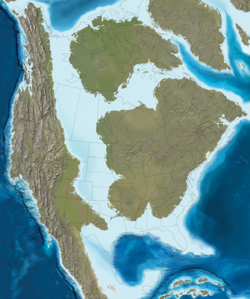Blood Reserve Formation
Topic: Earth
 From HandWiki - Reading time: 3 min
From HandWiki - Reading time: 3 min
| Blood Reserve Formation Stratigraphic range: Campanian ~73–76 Ma | |
|---|---|
| Type | Geological formation |
| Underlies | St. Mary River Formation |
| Overlies | Bearpaw Formation |
| Thickness | up to 30 metres (100 ft)[1] |
| Lithology | |
| Primary | Sandstone |
| Location | |
| Coordinates | [ ⚑ ] : 49°29′N 112°59′W / 49.48°N 112.99°W |
| Region | |
| Country | |
| Type section | |
| Named for | Blood Indian Reserve No. 148 |
| Named by | L.S. Russell[2] |
| Year defined | 1932 |
| Lua error in Module:Location_map/multi at line 27: Unable to find the specified location map definition: "Module:Location map/data/Alberta" does not exist. | |
The Blood Reserve Formation, also known as the Blood Reserve Sandstone, is a geologic formation of Late Cretaceous (Campanian) age in the Western Canada Sedimentary Basin.[3] It is present in southwestern Alberta, Canada , and was named for Blood Indian Reserve No. 148 by L.S. Russell in 1932.[2][1] It is an aquifer and a source of fresh groundwater.[4]
Lithology and environment of deposition
The Blood Reserve Formation consists of hard, cliff-forming, fine- to medium-grained sandstones. They range in colour from light grey to grey-buff on fresh surfaces, and weather to buff, yellow and greenish.[1] They are cemented by calcite and argillaceous minerals. Cross-bedding and irregular calcite concretions are common in the middle and upper portions.[4] Ophiomorpha burrows are common in the lower part.[4]
The Blood Reserve sandstones are interpreted as shoreline, barrier island and tidal inlet deposits.[1][4][5]
Thickness and distribution
The Blood Reserve Formation outcrops in a narrow belt that extends from the Canada–United States border where it is about 30 metres (100 ft) thick, to the Oldman River area where it is about 12 metres (40 ft) thick. It dips westward and is present in the subsurface west of the outcrop belt.[4]
Relationship to other units
The Blood Reserve Formation rests conformably on the marine shales and siltstones of the Bearpaw Formation, and is overlain by the floodplain deposits of the St. Mary River Formation. Its contacts with both are sharp. It is a continuation of the Horsethief Sandstone of northern Montana. It is correlated with the Black Eagle Member of the Bearpaw Formation in the Cypress Hills of southeastern Alberta, and with the lower part of the Horseshoe Canyon Formation to the north.[1]
Paleontology
Trace fossils such as Ophiomorpha burrows, fossil wood with Teredolites borings, and rare Macaronichnus burrows have been reported from the Blood Reserve Formation.[4][5]
References
- ↑ 1.0 1.1 1.2 1.3 1.4 Glass, D.J. (editor) 1997. Lexicon of Canadian Stratigraphy, vol. 4, Western Canada including eastern British Columbia, Alberta, Saskatchewan and southern Manitoba. Canadian Society of Petroleum Geologists, Calgary, 1423 p. on CD-ROM. ISBN:0-920230-23-7.
- ↑ 2.0 2.1 Russell, L.S. 1932. Stratigraphy and structure of the eastern portion of the Blood Indian Reserve, Alberta. Geological Survey of Canada, Summary Report 1931, part B, p. 26-38.
- ↑ Canadian Society of Petroleum Geologists (1994). "The Geological Atlas of the Western Canada Sedimentary Basin, Chapter 24: Upper Cretaceous and Tertiary strata of the Western Canada Sedimentary Basin". http://ags.aer.ca/reports/atlas-of-the-western-canada-sedimentary-basin.htm. Retrieved 2016-06-20.
- ↑ 4.0 4.1 4.2 4.3 4.4 4.5 Lerand, M.M. 1983. Sedimentology of the Blood Reserve Sandstone in southern Alberta. Canadian Society of Petroleum Geologists Field Trip Guidebook, August 1983, 55 p.
- ↑ 5.0 5.1 Nadon, G. 1988. Tectonic controls on sedimentation within a foreland basin: the Bearpaw, Blood Reserve and St. Mary River Formations, southwestern Alberta. Canadian Society of Petroleum Geologists Field Trip Guidebook, September 1988, 84 p.
 |
 KSF
KSF
